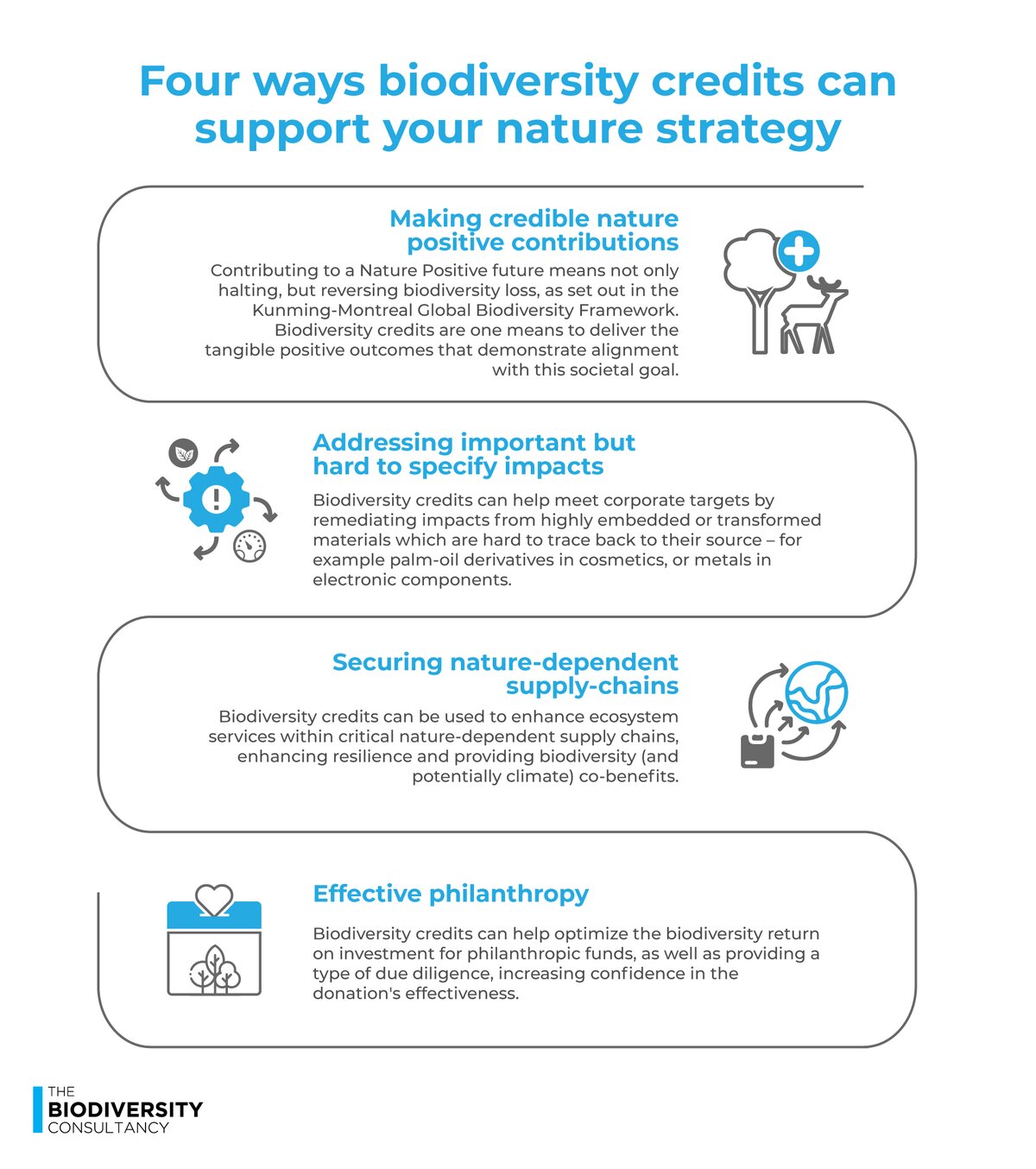Four ways biodiversity credits can support your nature strategy - and one they probably can't
The conversation about biodiversity credits got started just over a year ago at the Fifteenth meeting of the Conference of the Parties of the Convention on Biological Diversity (CBD COP15) in Montreal. The discourse on panels, in the hallways and in hotel lobbies quickly moved to the question of “why”?. Why would a company be interested in buying voluntary biodiversity credits?
Consensus soon emerged that they should not be used as biodiversity offsets, that is they shouldn’t be used to compensate for demonstrable, attributable corporate impacts on nature. However, during one question and answer session I sat in on, an audience member asked the panel: If biodiversity credits aren’t going to be offsets, why should I buy them?
It was a good question then, and one that continues to be asked 12 months on.
Well, there are several ways voluntary biodiversity credits might help you deliver your nature strategy, and make genuine contributions to a nature positive future, as well as one where they are still unlikely to be appropriate.
UNDERSTANDING VOLUNTARY BIODIVERSITY CREDITS
There is not yet any universally agreed definition for the term so different people may be associating it with different meanings, but at TBC, we define biodiversity credits as standardised measures of positive biodiversity outcomes. These units of biodiversity are generated and sold by one or more actors through the conservation or restoration of biodiversity, and they are validated and monitored throughout times.
Standardised units of biodiversity are necessary to measure, value and sell credits within a market. But, these units do not tell you much about which biodiversity, be that plants or animals, fungi or ecosystems, benefits from any one specific credit – some may generate habitat for tigers, others conserve caves for bats. Both outcomes are good for nature, but how can they also be right for your nature strategy?
SITUATIONS WHERE VOLUNTARY BIODIVERSITY CREDITS MIGHT BE APPROPRIATE
One way of looking at different options your company has for using credits to meet its nature commitments is through the lens of “equivalence”. Basically this is about whether the credits are supporting conservation of the same types of biodiversity that a company is having a negative impact on. Are the conservation positives equivalent to the negative impacts? How important equivalence is to a company considering biodiversity credits depends on the claims they are making about why they are using them.
So, when could you use voluntary biodiversity credits?
Making credible nature positive contributions
These are contributions towards positive actions for biodiversity within or outside your value chain which help meet societal goals such as those in the Kunming-Montreal Global Biodiversity Framework. Frameworks are being developed to help companies identify beneficial actions, for example those proposed by IUCN. Of fundamental importance in credible claims to supporting a nature positive future however is meaningful and ambitious actions to avoid and reduce your impacts across the value chain. Some equivalence would be beneficial, as it would show that the credits are coming from an area linked to the company’s supply chain.
Example: Company A has taken measures to address ongoing or new impacts in a key sourcing landscape, but it is keen to work with other landscape actors to address historical impacts. Biodiversity credits can be a way of ensuring that investments lead to demonstrable improvements that align with a region or country’s conservation priorities.
Addressing potential, but hard to specify impacts
Some elements of your value chain derive from highly transformed derivative materials that are hard to trace back to source – often agricultural products or minerals. In this case, buying credits can help meet corporate targets to remediate impacts. Some equivalence is expected, as credits are being used to address hard-to-measure, diffuse, but known impacts in the value chain.
Example: Company B uses chemicals derived from coconuts in its value chain. The derivatives are bought in small quantities but are essential to Company B’s product. The small volumes, and heavily derived nature make traceability to sourcing region impractical. The company has committed to supporting a nature positive future, and to remediating potential negative impacts to achieve this so buys credits that support nature conservation in coconut producing regions.

Securing nature-dependent supply-chain
Ecosystem services may have been identified as critical dependencies in a your supply chain. Purchasing credits to maintain or enhance these services can improve supply chain resilience and bring biodiversity – and potentially climate – co-benefits. Some equivalence will be expected if you want to make claims about biodiversity co-benefits.
Company C has identified a lack of pollinating species, like bees and butterflies, and soil erosion as key risks to its agricultural supply chain. Company C works with a partner organisation to implement a programme to increase the area of semi-natural habitat in its production farms. The partner organisation’s work helps to create co-benefits for biodiversity and generates the credits that Company C buys to support the programme.
Effective philanthropy
If you want to use philanthropic funds effectively, biodiversity credits can both help you maximise biodiversity gains – biodiversity return on investment- and be a good form of due diligence. There is no connection to negative impacts and so no expectation of equivalence, but there is greater confidence that the donation is doing good.
Example: Employees in Company D have voted for nature conservation to be the focus of their “good causes fund”. Company D does not have any negative biodiversity impact to address — this is purely a case where the employees simply want to contribute towards a nature-positive goal. In this case, buying a biodiversity credit may be an effective way for Company D to make a verified claim to positive impact.
AND A CASE WHERE VOLUNTARY BIODIVERSITY CREDITS ARE UNLIKELY TO BE APPROPRIATE – AT LEAST FOR NOW.
Compensating for demonstrable and attributable impacts to biodiversity
If you know there are negative impacts to biodiversity that are fully, or largely under your control or influence, voluntary credits are currently not a solution. Firstly, you should be doing everything you can to avoid or minimise the impacts in the first place, and to restore damaged areas where feasible. This is applying the mitigation hierarchy. If there are still un-resolved impacts, then additional, highly equivalent ecological compensation will be expected. Potentially through biodiversity offsets. The offsets need to be of the same type of biodiversity that has been impacted, and the offset must lead to measurable improvements in the same biodiversity. Voluntary biodiversity credits might not be available for the same type of biodiversity as the impact, or lead to sufficient improvements that would more than compensate for the impact. They would only be suitable for offsets if they have been specifically designed for that – which is currently very rarely the case.
Voluntary biodiversity credits are still of interest? Here’s what’s next
Before your company enters the market for voluntary biodiversity credits, ask yourself the following questions.
-
Is your company taking bold actions to avoid and reduce impacts to biodiversity throughout the value chain? Credible nature strategies must have impact reduction at their core.
-
Why are you considering voluntary biodiversity credits, and what outcomes do you want?
-
What claims will you be making about your use of biodiversity credits as part of your nature strategy?
-
Have you done due diligence to check the credits that you will buy will actually deliver what you need, and are generated in a fair and equitable manner?
These are still early days for voluntary biodiversity credits, so there remains a lot of room for discussion on how best to match a company’s claims with the type of credit it intends to buy. This is something that The Biodiversity Consultancy is keen to explore, as we continue to support the development of high-integrity biodiversity credits.
Categories: Agriculture & forestry, Insight, Ecosystem Services, Biodiversity Strategy, Nature Positive, Biodiversity Offsets
Business & biodiversity
Join our mailing list to get the latest developments in business and biodiversity


